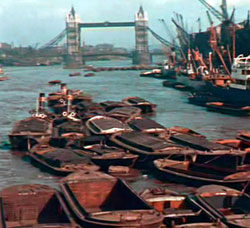Check out this rare, old color film footage showing life in London during the Roaring Twenties
posted Tuesday, May 14, 2013 at 1:36 PM EDT

Thanks to the Internet, more and more rare, early color photos of Paris, Russia, Ireland and other places are being shared and admired. Add to that treasure trove of turn-of-the-century color photography, this fantastic, old, color film footage of London captured by photographer Claude Friese-Greene in 1927. Using the Biocolour film process invented by his father William, Friese-Greene take us on a remarkable walkabout of what was then still the capital of a world spanning empire in this movie, titled "The Open Road."
Several of Friese-Greene's films, including this one, have been digitally processed and restored and although almost 90 years old, they still retain their quirky English humor and flavor. Friese-Greene's title cards, inserted throughout the films, are rather tongue-in-cheek commentaries on the scenes.
The Biocolour process invented by William Friese-Greene was an additive color film process in which every other frame of standard black-and-white film was exposed through either a red or a green color filter. This produced alternate monochrome negatives that captured different parts of the light spectrum. These images were then stained red or green and when projected they created the “illusion” of color.
The process, unfortunately, suffered from severe flickering and from color fringing of images of rapidly moving objects. To reduce these problems, the Biocolour films were shot at a higher frame rate than the typical black-and-white film of the day. When William died in 1921, Claude continued improving the process and renamed it the Friese-Greene Natural Colour Process. It was used in the 1920s and into the 1930s but ultimately with the development of sound movies and alternative color processes, like Technicolor, which arrived in the 1920s, it disappeared. The videos we have today were made from the original films by the British Film Institute using computer enhancement to reduce the noticeable flickering that was still seen in the original footage.
Friese-Greene’s 1927 London is fascinating because it is a record of daily life in the metropolis. Like most travelogues, the film takes us to the usual touristic sights of London, such as the Beefeater guards at Buckingham Palace the Tower of London, and there is a lot of time spent simply gazing at the passing scene. Men in flat caps and women in the latest flapper dresses are seen ambling down city streets at a leisurely pace that is a far cry from the modern London. Changes are evident too, as we see red double-decker buses full of people on their way to work sharing the road with horse-drawn wagons delivering their wares to local shops.
"The Open Road" lets us experience a familiar world of not so long ago and we can marvel at both how much the world has changed and how little. I wonder if perhaps in another 90 years, people will look back at us, at our videos and photographs, and marvel at who we were, "back then."
(Via Phoblographer and PetaPixel)